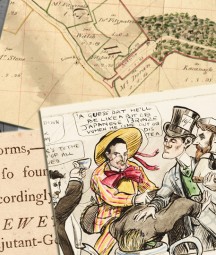by Daniel Casey (National Photographic Archive / Dublin Institute of Technology Archival Internship 2014)
I completed an internship as part of the annual collaborative partnership between the National Photographic Archive (NPA) and the DIT School of Photography from September to December 2014. The internship provided me with a fantastic opportunity to have practical experience of working with a previously uncatalogued photographic collection, following on from a solid introduction to theories about the Archive in my second year of the BA Photography programme.
From the large quantities of uncatalogued material in the NPA one box was selected for me to work on. The box contained 74 postcards known as the Lawrence Postcard Roche Collection. Elizabeth Kirwan, Curator at the NPA and Keith Murphy, Reading Room Manager, who were invaluable throughout the internship, provided as much background information as they had. The 74 postcards were removed from a larger collection of postcards named the Roche collection. The postcards selected were Lawrence postcards, which we know as there is an imprint of Lawrence Publisher, Dublin printed on the left side as in Figure 1.
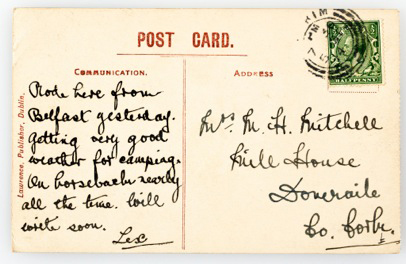
Figure 1 Antrim Castle, Antrim
The extraction of the selected postcards over other items in the Roche Collection was simply due to the interest in material relating to the Lawrence Collection. The Lawrence Collection is particularly important to the NPA. Its holdings of 40,000 glass plates were bought by the National Library of Ireland in 1943 and a significant number of printing blocks and albums were acquired later.
For any collection, it is important to know its provenance. An examination of the Roche Postcard collection turned up an acquisition note for the postcards, stating that half the collection was presented by a Mr. P. Flood and the other half by a Mr. F E Dixon on the 22 April 1980. Information on Mr. P. Flood proved elusive but Mr. F. E. Dixon was a president of the Old Dublin Society and entries relating to him were found in the Dublin Historical Records. He is mentioned by Frank Staff (Staff, 1966) and Kieran Hickey (Hickey, 1973) as being helpful to their research, and the items he donated to Dublin City Libraries can be found in a collection known as the Dixon slides.
The Roche element of the collection name is explained by its frequent occurrence among the addressees on the sent postcards. Postcards were received by Roche and Mitchell in Doneraile, Co Cork and Brookville, Ballnacurra, Co Limerick and again in Glasgow, accounting for 39 cards sent, or half of the collection. The second most popular name is that of Mrs. Irvine who had an address in Rathmines and Sandymount in Dublin, accounting for eight postcards received.
Other key information about the postcards was obtained by breaking down the constituent parts, such as the title of the postcard, the location represented, whether it was printed in colour or not, the franking, manuscript date, manufacturers text, whether it was sent or unsent, and if it matched other related materials when cross-referenced. One can date the postcards from the franking and the fact that postcards in 1902 for the first time had an image on one side with spaces for both message and address on the other. I recorded what was visible from the franking, and based on this information the earliest year of postage appears to have been 1905 and the latest 1916.
While the majority of the items are topographical views with a location mentioned on the image side of the postcard, it was decided to order the items in alphabetical order starting with the place or county, then town and so forth. Figure 2 Antrim Castle, postcard shows the title on the bottom left corner.
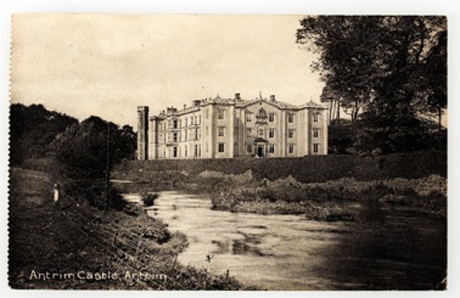
Figure 2 Antrim Castle, Antrim
Fifteen counties are represented, with Co Clare occurring the most, on 14 postcards and Counties Kerry and Wicklow next. The random nature of these results can be explained by a number of different factors. For example, it could be the personal preference of the collector for a particular county, the aesthetic view, or the type of postcard. On each of the postcards in the Lawrence Postcard Roche Collection the location of where the image was taken is printed. It is generally readable, but not on all postcards, as this information can be obscured where the stamp was affixed. From the 74 postcards, 23 were readable, 20 of these stated they were printed in Germany or Saxony and the last three were printed in England, Ireland, or France.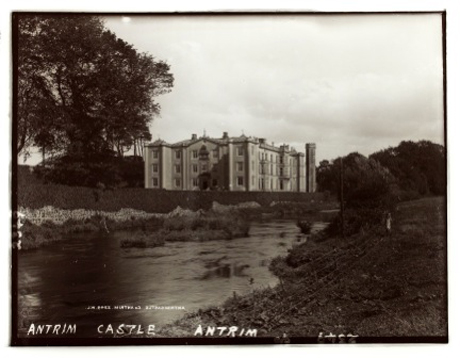
Figure 3 Antrim Castle, glass plate
As part of my research, I cross-referenced the NLI online catalogue with the title of a postcard from the Lawrence Postcard Roche Collection and the Lawrence Collection glass plate negatives, and also with the Lawrence Collection postcard photogravures. This resulted in visual matches with the digitised glass plates in the Lawrence Collection (for example, see Figure 3, Antrim Castle, glass plate). There are 886 copper printing blocks in the Lawrence collection for the production of postcards, an example of which is seen in Figure 4. Antrim Castle, printing block. The blocks were catalogued by Chantal Sweeney (Sweeney, 2012), but how they arrived at the NPA is unclear. A cross-referencing of these printing blocks was undertaken and 17 matching titles were found, of which 13 were visual matches.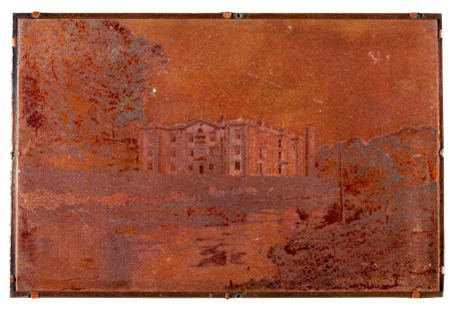
Figure 4 Antrim Castle, printing block
While there are differences between the title of the postcard and the title of the glass plate in the collection, matches were able to be made by close examination of the details in similarly titled items. Some items share the same title but do not match. Thirty-seven postcards, or over half of the postcards, can be traced in this manner to the glass plates acquired in 1943 and are credited with being the work of Robert French, one of Lawrence's leading photographers.
My final task was rehouse the postcards to preserve them for future use in a way which would allow for improved access to them but also protect them from coming into contact with other materials. They were placed in Mylar housing which could be then be put into an acid-free ring binder.
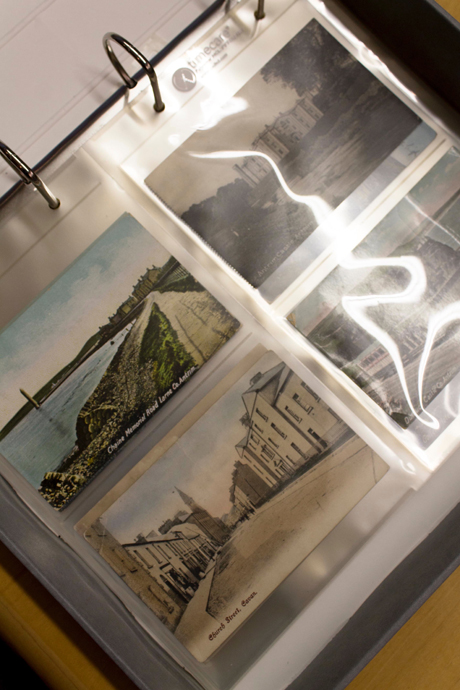
Figure 5 Rehoused Postcards in Mylar
With more time, I would like to have uncovered more information on the collecting habits of F. E. Dixon and the Roche family. The Lawrence business model would be interesting also to examine more comprehensively in order to understand the broader printing processes and distribution mechanism for the postcards.
The work I completed in the NPA has given the postcards a value in the multi-layered story surrounding the Lawrence collection. It ties the postcards with the glass plate negatives that generated the printing blocks used for printing the postcards with the photographs possibly originally taken by Robert French. The postcards were sold to the public who wrote their messages to loved ones or business partners and sent them through the postal system. They were retained for sentimental value or the aesthetic appreciation of the image, ultimately to be collected by a collector and preserved by the NPA. They are available to the public once again for consideration in the context of the wider cultural and social impact of photography.
